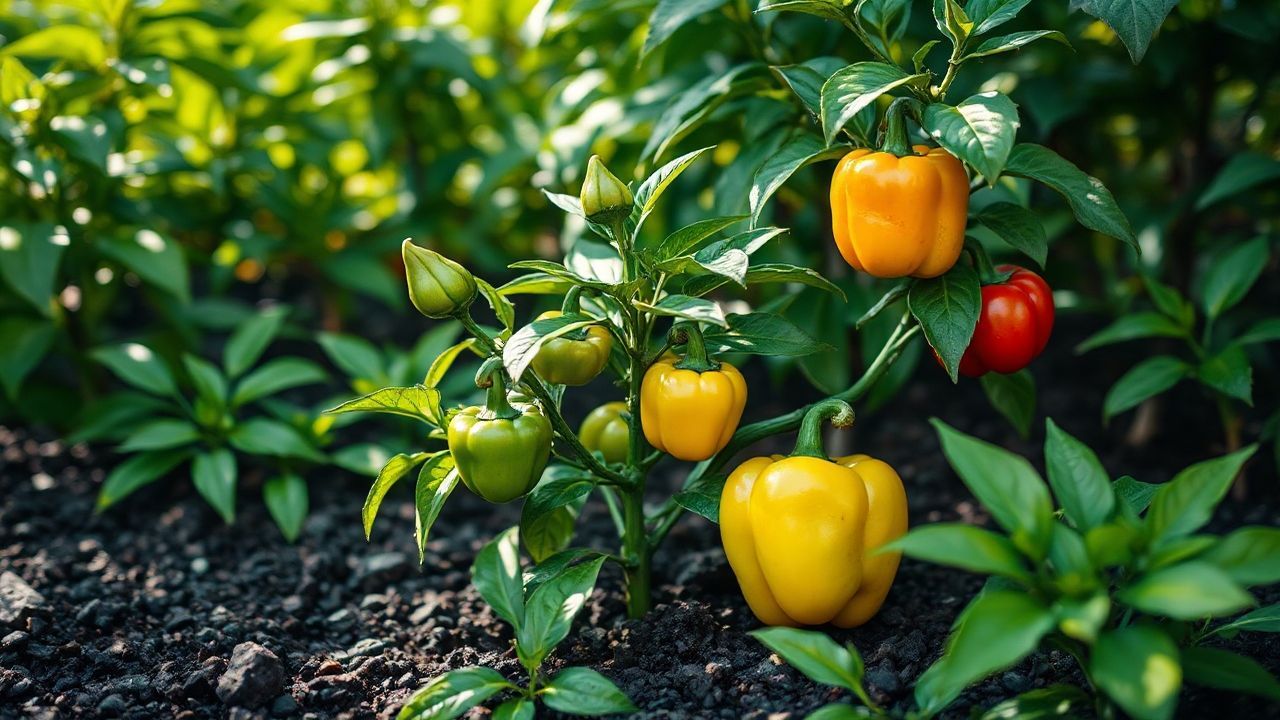Introduction to bell peppers
Bell peppers originate from South and Central America, where they were domesticated thousands of years ago. They are classified as annual plants, completing their life cycle within a single growing season. Depending on the variety, bell peppers can range in size, shape, and color, with the most common colors being green, red, yellow, and orange. Each pepper consists of a hollow interior divided into three or four chambers that contain numerous small, flat seeds.
Bell peppers thrive in warm, sunny climates and well-drained soil. They typically require a long growing season of around 120 to 150 days from seed to maturity. The plants grow upright, reaching heights of up to 2-3 feet (60-90 cm), and produce abundant foliage. During the growing season, bell peppers undergo several stages of development, including germination, vegetative growth, flowering, fruiting, and ripening.
The germination process begins when the seeds are planted in moist soil. Under ideal conditions, the seeds will germinate within 7-10 days. The germinated seeds develop into seedlings with small, true leaves. As the seedlings continue to grow, they develop more leaves and establish a root system.
During the vegetative growth stage, the plants allocate their resources to producing leaves and stems. This stage is crucial for establishing a healthy plant structure that can support fruit production. Once the plants have reached a certain size and maturity, they enter the flowering stage.
Life cycle of bell pepper plants
The vegetative growth stage follows, characterized by the development of the plant’s leaves, stems, and branches. During this stage, the plant focuses on maximizing its photosynthetic capacity, converting sunlight into energy through its green leaves. As the plant matures, it enters the reproductive stage, marked by the appearance of flower buds. These buds eventually develop into bell pepper flowers, each containing both male and female reproductive organs.
Self-pollination or pollination by insects and wind ensures fertilization, leading to the formation of small, green peppers. These peppers continue to grow and develop, accumulating water, nutrients, and sugars. As they mature, they gradually change color, transitioning from green to shades of red, yellow, or orange, indicating their readiness for harvest.
The final stage of the bell pepper plant’s life cycle is its senescence or aging phase. After producing a substantial yield of peppers, the plant’s foliage begins to yellow, and its growth slows down. The leaves eventually die back, and the plant redirects its remaining energy into ripening any remaining peppers. Once the life cycle is complete, the plant dies, leaving behind a legacy of flavorful bell peppers that have nourished and delighted countless people.
Ideal growing conditions
Caring for bell pepper plants
Bell peppers thrive in well-drained, fertile soils with a pH ranging from 6.0 to 6.8. They prefer full sun exposure for at least six hours daily, as this promotes vigorous growth and abundant fruit production. The ideal temperature range for bell pepper cultivation is between 65°F and 85°F (18°C – 29°C). Temperatures below 55°F (13°C) or above 95°F (35°C) can hinder growth and negatively impact fruit development. Mulching around the plants helps retain soil moisture, suppress weeds, and regulate soil temperature.
Seedlings are typically started indoors 6-8 weeks before the last frost date in the spring. Seeds should be sown shallowly in a seed-starting mix and kept warm and moist. Once seedlings emerge, they should be thinned out to allow for proper growth and air circulation. After the risk of frost has passed, seedlings can be transplanted outdoors.
When transplanting, space the plants 18-24 inches apart to provide adequate room for growth and fruit production. Water deeply after transplanting and continue to water regularly, especially during hot and dry weather. Mulch around the plants with organic matter to maintain moisture, suppress weeds, and regulate soil temperature.
Fertilize bell pepper plants every 3-4 weeks with a balanced fertilizer. Follow the instructions on the fertilizer label carefully to avoid overfertilization, which can damage plants. Blossom end rot, a common problem in bell peppers, can be prevented by ensuring adequate calcium levels in the soil.
Regularly inspect bell pepper plants for pests and diseases and take appropriate control measures if necessary. Some common pests include aphids, whiteflies, and spider mites. Diseases such as powdery mildew, blossom end rot, and bacterial leaf spot can also affect bell pepper plants. By following these care tips, you can cultivate healthy and productive bell pepper plants that will reward you with a bountiful harvest of sweet and crisp peppers.
Harvesting bell peppers
The bell pepper’s journey begins with the sowing of seeds in a warm, well-drained soil. With adequate sunlight and moisture, the seeds germinate and sprout into small seedlings. As they grow, the plants develop sturdy stems and lush green leaves. During the vegetative stage, they focus on producing a strong root system and ample foliage to support the upcoming fruit production. With proper care and nutrient-rich soil, the plants transition into the reproductive stage, where the magic of pepper formation unfolds.

Leave a Reply